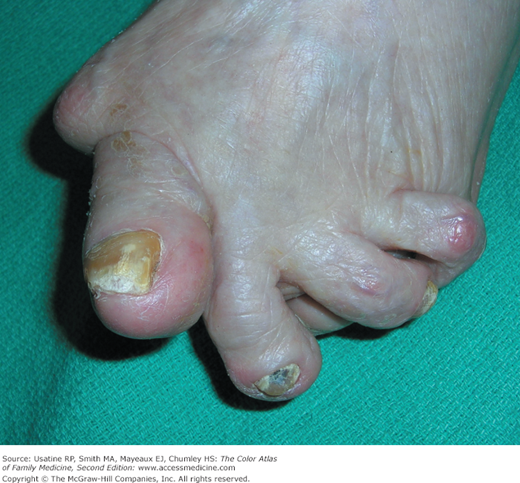Patient Story
A 79-year-old woman with late-stage rheumatoid arthritis comes for routine follow-up (Figures 97-1, 97-2, 97-3, and 97-4). She began having hand pain and stiffness approximately 40 years ago. She took nonprescription medications for pain for approximately 10 years before seeing a physician. She was diagnosed with rheumatoid arthritis on the basis of combination of clinical, laboratory, and radiograph findings. She was treated with prednisone and tried most of the disease-modifying agents as they became available; however, her disease progression continued. Approximately 10 years ago, she began having increased foot pain and difficulty walking. Today, she works with a multidisciplinary team to control pain and preserve hand function and independence.
Introduction
Rheumatoid arthritis (RA) is a progressive chronic illness that causes significant pain and disability. RA is a polyarticular inflammatory arthritis that causes symmetrical joint pain and swelling and typically involves the hands. Early recognition and treatment with nonbiologic and/or biologic disease-modifying antirheumatologic agents (DMARDs) can induce remission and preserve function.
Epidemiology
Etiology and Pathophysiology
- Genetic predisposition coupled with an autoimmune or infection-triggering incident.
- Synovial macrophages and fibroblasts proliferate, leading to increased lymphocytes and endothelial cells.
- Increased cellular material occludes small blood vessels, causing ischemia, neovascularization, and inflammatory reactions.
- Inflamed tissue grows irregularly, causing joint damage.
- Damage causes further release of cytokines, interleukins, proteases, and growth factors, resulting in more joint destruction and systemic complications including a higher risk for cardiovascular disease
Diagnosis
The 2010 American College of Rheumatology/European League Against Rheumatism classification criteria uses a scoring system to designate patients as definite RA. A score of 6 or greater out of 10 meets criteria for definite RA.2
- Joint involvement—1 large joint (0 points); 2 to 10 large joints (1 point); 1 to 3 small joints with or without large joints (2 points); 4 to 10 small joints with or without large joints (3 points); more than 10 joints with at least 1 small joint (5 points).
- Serology—Negative rheumatoid factor (RF) and anticitrullinated protein antibody (ACPA) (0 points); low positive RF or ACPA (2 points); high positive RF or ACPA (3 points).
- Acute-phase reactants—Normal C-reactive protein (CRP) and erythrocyte sedimentation rate (ESR) (0 points); abnormal CRP or ESR (1 point).
- Duration of symptoms—Less than 6 weeks (0 points); 6 or more weeks (1 point).
- Stiffness around joint for 1 hour after inactivity (LR+1.9).
- Three or more of these have soft-tissue swelling—Wrist, proximal interphalangeal (PIP), metacarpophalangeal (MCP), elbow, knee, ankle, metatarsophalangeal (MTP) (LR+1.4).
- Hand joints involved (LR+1.5) (Figures 97-1, 97-4, and 97-5).
- Symmetrical involvement of one of these: wrist, PIP, MCP, elbow, knee, ankle, MTP (LR+1.2).
- Subcutaneous nodules (LR+3.0) (Figures 97-5 and 97-6).
- Positive serum RF (LR+8.4).
- Osteopenia or erosion of surrounding joints on hand or wrist films (LR+11) (Figures 97-7 and 97-8

Stay updated, free articles. Join our Telegram channel

Full access? Get Clinical Tree






